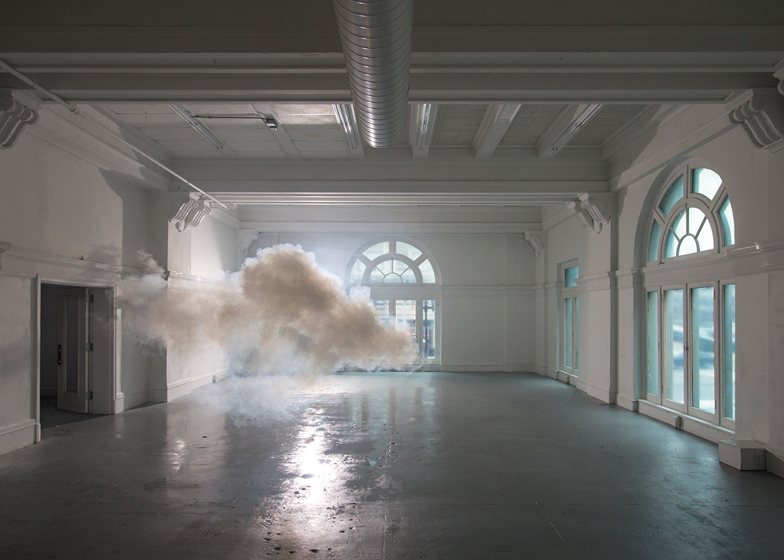A Dutch artist has captured a fluffy white cloud in a beaux-arts style room in San Francisco for the latest in his series of photographs of indoor clouds (+ slideshow + interview).
Berndnaut Smilde creates his indoor clouds using a smoke machine. He adjusts the humidity of the room by spraying water, and reduces the temperature - this allows the smoke to take a cloud-like shape for just long enough to be photographed before it dissipates.
"It has to be cold, damp and really wet, so I'm moisturising the air as much as possible," Smilde said in an interview with the BBC. "The moisture will stick to the smoke, making it heavier."
"I cannot really control the cloud - it's different every time. So, I create hundreds and hundreds [of images] and select just one to be the [final] work," Smilde said.
Smilde spoke to Dezeen about his latest installation, Nimbus Green Room, which he created at the San Francisco War Memorial and Performing Arts Center, "The space is kitsch, but it has great architectural ornaments," Smilde said.
"As you probably know the Green Room is an American interpretation of the mirror room [Hall of Mirrors] in the Palace of Versailles, France. Its interior is classic and symmetrical, and represents perfection," he added. "The green walls and features such as the chandeliers almost look like they've turned into plastic because of the extreme sharpness of the photographs."
For his Nimbus photography series, Smilde has created indoor clouds within buildings including the Hotel MariaKapel in the Netherlands and Aspremont-Lynden Castle in Belgium.
Smilde's clouds were listed by TIME Magazine as one of the top 10 inventions of 2012.
Other stories we've posted on Dezeen recently include a cloud-shaped holiday cabin in south-west France, a warehouse filled with luminous clouds in Toronto and a weather-forecasting lamp that creates an indoor cloud to warn of grey skies outside.
See more weather features »
See more installations »
Photographs are courtesy of Ronchini Gallery.
Here's the full interview with Smilde:
Kate Andrews: Can you tell us about the motivations behind your cloud installations? How did this start?
Berndnaut Smilde: The idea started when I was working in a small scale space for art projects. Model spaces are a recurring subject in my work. Because you have total control over these spaces it enables you to create an ideal situation. This is one of the reasons I think a model can stand for an idea. I wanted to see if it would be possible to exhibit a raincloud. I've modelled the exhibition space after my ideal perception of a museum space and wanted to create an ominous situation.
Kate Andrews: What's unique about the Nimbus Green Room from your other installations? Can you tell us a little about the building and the interior space?
Berndnaut Smilde: The Green Room is a great example of a representation of an ideal space. As you probably know the Green Room is an (American) interpretation of the mirror room in the castle of Versailles. Its interior is classic and symmetrical and represents perfection.
The space is kitsch but it has great architectural ornaments. The materiality of the room really stands out and in the photographs. The green walls and features such as the chandeliers almost look like they've turned into plastic because of the extreme sharpness of the photographs.
I also like the reflection in the mirror. The room continues and you can see the backside of the cloud reflecting in it providing the work with an extra dimension.
Kate Andrews: Do you take your own photography?
Berndnaut Smilde: I am not a photographer and always work with local professionals. In San Francisco I worked with RJ Muna. He was great to work with and had fantastic equipment.
Kate Andrews: How does architecture and interior space affect your work?
Berndnaut Smilde: My work is often about situations that deal with duality. They question: inside and outside, size, the function of materials and architectural elements. Lots of time I work in a site-specific way reacting to the architecture or history of a location.
I am interested in in-between situations and situations that don't really have a function yet and are to me therefore open for interpretation. Sometimes I create these situations, like I did with the clouds.
I also like to collect these moments when I see one. For instance the work Bored Art (2008) represents a 'found situation' were a painting is resting against the wall for a brief abandoned moment. Here it is the context of its surrounding (the museum) that changes the interpretation of this painting and situation.
Kate Andrews: What will you be working on next?
Berndnaut Smilde: I am preparing for a project at the Bonnefanten Museum in Maastricht, where I will be creating an exhibition with their collection and my work.








